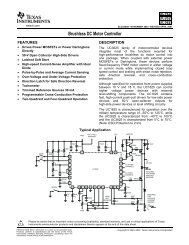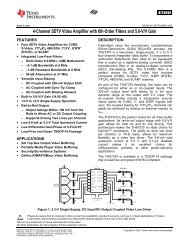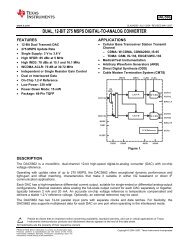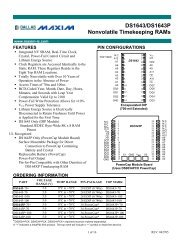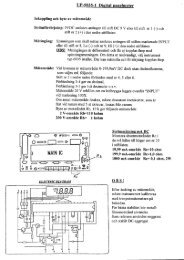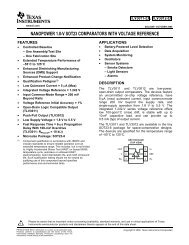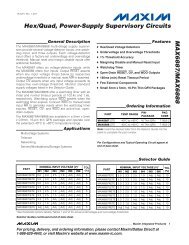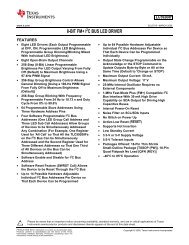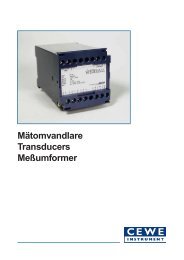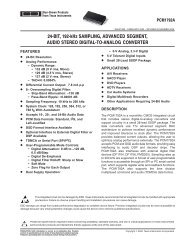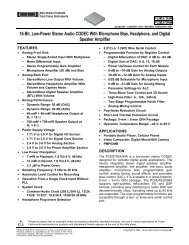Single-Chip Low Power RF Transceiver for Narrowband Systems ...
Single-Chip Low Power RF Transceiver for Narrowband Systems ...
Single-Chip Low Power RF Transceiver for Narrowband Systems ...
Create successful ePaper yourself
Turn your PDF publications into a flip-book with our unique Google optimized e-Paper software.
9.2. Signal Interface<br />
The CC1021 can be used with NRZ (Non-<br />
Return-to-Zero) data or Manchester (also<br />
known as bi-phase-level) encoded data.<br />
CC1021 can also synchronize the data from<br />
the demodulator and provide the data<br />
clock at DCLK. The data <strong>for</strong>mat is<br />
controlled by the DATA_FORMAT[1:0] bits<br />
in the MODEM register.<br />
CC1021 can be configured <strong>for</strong> three<br />
different data <strong>for</strong>mats:<br />
Synchronous NRZ mode<br />
In transmit mode CC1021 provides the data<br />
clock at DCLK and DIO is used as data<br />
input. Data is clocked into CC1021 at the<br />
rising edge of DCLK. The data is<br />
modulated at <strong>RF</strong> without encoding.<br />
In receive mode CC1021 per<strong>for</strong>ms the<br />
synchronization and provides received<br />
data clock at DCLK and data at DIO. The<br />
data should be clocked into the interfacing<br />
circuit at the rising edge of DCLK. See<br />
Figure 9.<br />
Synchronous Manchester encoded<br />
mode<br />
In transmit mode CC1021 provides the data<br />
clock at DCLK and DIO is used as data<br />
input. Data is clocked into CC1021 at the<br />
rising edge of DCLK and should be in NRZ<br />
<strong>for</strong>mat. The data is modulated at <strong>RF</strong> with<br />
Manchester code. The encoding is done<br />
by CC1021. In this mode the effective bit<br />
rate is half the baud rate due to the<br />
coding. As an example, 19.2 kBaud<br />
Manchester encoded data corresponds to<br />
9.6 kbps.<br />
In receive mode CC102 per<strong>for</strong>ms the<br />
synchronization and provides received<br />
data clock at DCLK and data at DIO.<br />
CC1021 per<strong>for</strong>ms the decoding and NRZ<br />
data is presented at DIO. The data should<br />
be clocked into the interfacing circuit at the<br />
rising edge of DCLK. See Figure 10.<br />
In synchronous NRZ or Manchester mode<br />
the DCLK signal runs continuously both in<br />
RX and TX unless the DCLK signal is<br />
gated with the carrier sense signal or the<br />
PLL lock signal. Refer to section 21 <strong>for</strong><br />
more details.<br />
CC1021<br />
If SEP_DI_DO = 0 in the INTE<strong>RF</strong>ACE<br />
register, the DIO pin is the data output in<br />
receive mode and data input in transmit<br />
mode.<br />
As an option, the data output can be made<br />
available at a separate pin. This is done<br />
by setting SEP_DI_DO = 1 in the<br />
INTE<strong>RF</strong>ACE register. Then, the LOCK pin<br />
will be used as data output in synchronous<br />
mode, overriding other use of the LOCK<br />
pin.<br />
Transparent Asynchronous UART<br />
mode<br />
In transmit mode DIO is used as data<br />
input. The data is modulated at <strong>RF</strong> without<br />
synchronization or encoding.<br />
In receive mode the raw data signal from<br />
the demodulator is sent to the output<br />
(DIO). No synchronization or decoding of<br />
the signal is done in CC1021 and should be<br />
done by the interfacing circuit.<br />
If SEP_DI_DO = 0 in the INTE<strong>RF</strong>ACE<br />
register, the DIO pin is the data output in<br />
receive mode and data input in transmit<br />
mode. The DCLK pin is not active and can<br />
be set to a high or low level by<br />
DATA_FORMAT[0].<br />
If SEP_DI_DO = 1 in the INTE<strong>RF</strong>ACE<br />
register, the DCLK pin is the data output in<br />
receive mode and the DIO pin is the data<br />
input in transmit mode. In TX mode the<br />
DCLK pin is not active and can be set to a<br />
high or low level by DATA_FORMAT[0].<br />
See Figure 11.<br />
Manchester encoding and decoding<br />
In the Synchronous Manchester encoded<br />
mode CC1021 uses Manchester coding<br />
when modulating the data. The CC1021<br />
also per<strong>for</strong>ms the data decoding and<br />
synchronization. The Manchester code is<br />
based on transitions; a “0” is encoded as a<br />
low-to-high transition, a “1” is encoded as<br />
a high-to-low transition. See Figure 12.<br />
The Manchester code ensures that the<br />
signal has a constant DC component,<br />
which is necessary in some FSK<br />
demodulators. Using this mode also<br />
ensures compatibility with CC400/CC900<br />
designs.<br />
SWRS045B Page 25 of 89



